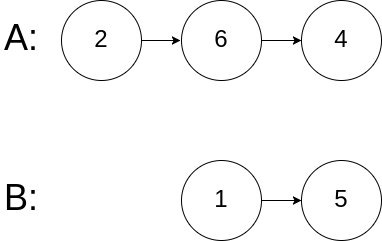I tried LeetCode every day 160. Intersection of Two Linked Lists (Python, Go)
What is Leetcode
leetcode.com This is the practice of coding interviews for software developers. A total of more than 1,500 coding questions have been posted, and it seems that the same questions are often asked in actual interviews.
Introduction to golang + algorithm I will solve it with go and Python to strengthen the brain.
36th question (question 160)
- Intersection of Two Linked Lists
the issue's details
Write a program to find the node at which the intersection of two singly linked lists begins.
For example, the following two linked lists:
begin to intersect at node c1.
Example 1:
Input: intersectVal = 8, listA = [4,1,8,4,5], listB = [5,6,1,8,4,5], skipA = 2, skipB = 3 Output: Reference of the node with value = 8 Input Explanation: The intersected node's value is 8 (note that this must not be 0 if the two lists intersect). From the head of A, it reads as [4,1,8,4,5]. From the head of B, it reads as [5,6,1,8,4,5]. There are 2 nodes before the intersected node in A; There are 3 nodes before the intersected node in B.Example 2:
Input: intersectVal = 2, listA = [1,9,1,2,4], listB = [3,2,4], skipA = 3, skipB = 1 Output: Reference of the node with value = 2 Input Explanation: The intersected node's value is 2 (note that this must not be 0 if the two lists intersect). From the head of A, it reads as [1,9,1,2,4]. From the head of B, it reads as [3,2,4]. There are 3 nodes before the intersected node in A; There are 1 node before the intersected node in B.Example 3:
Input: intersectVal = 0, listA = [2,6,4], listB = [1,5], skipA = 3, skipB = 2 Output: null Input Explanation: From the head of A, it reads as [2,6,4]. From the head of B, it reads as [1,5]. Since the two lists do not intersect, intersectVal must be 0, while skipA and skipB can be arbitrary values. Explanation: The two lists do not intersect, so return null.Notes:
- If the two linked lists have no intersection at all, return
null.- The linked lists must retain their original structure after the function returns.
- You may assume there are no cycles anywhere in the entire linked structure.
- Each value on each linked list is in the range
[1, 10^9].- Your code should preferably run in O(n) time and use only O(1) memory.
Way of thinking
- Make a copy of each to proceed with headA and headB (p, q).
- Substitute headB when p goes to the end, and assign headA when q goes to the end.
- Loop until p and q are equal or both reach the end.
- Returns null if it's terminating, and that node if it's equal.
Answer code
class Solution(object):
def getIntersectionNode(self, headA, headB):
"""
:type head1, head1: ListNode
:rtype: ListNode
"""
if not headA or not headB:
return None
p,q = headA , headB
while p and q and p != q :
p = p.next
q = q.next
if p == q :
return q
if not p :
p = headB
if not q :
q = headA
return p
--I'll write it in Go too!
/**
* Definition for singly-linked list.
* type ListNode struct {
* Val int
* Next *ListNode
* }
*/
func getIntersectionNode(headA, headB *ListNode) *ListNode {
if headA == nil || headB == nil {
return nil
}
A := headA
B := headB
for A != B {
if A == nil {
A = headB
} else {
A = A.Next
}
if B == nil {
B = headA
} else {
B = B.Next
}
}
return A
}
Recommended Posts



